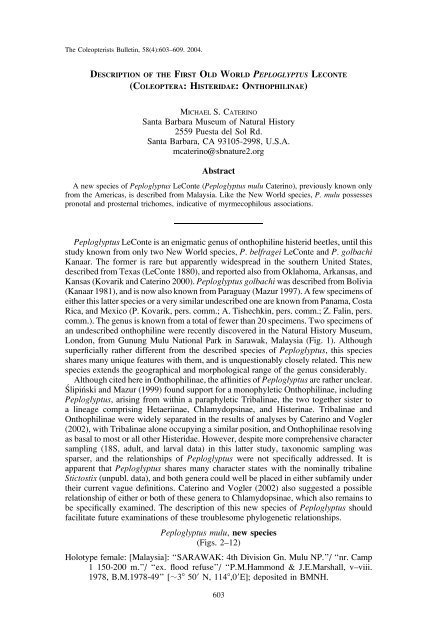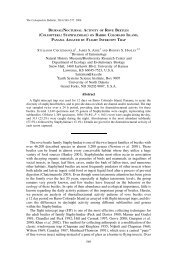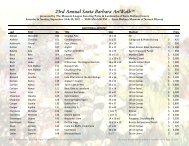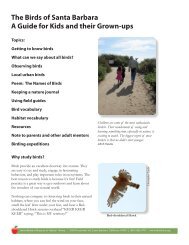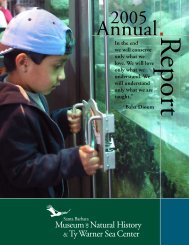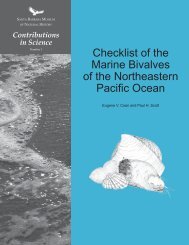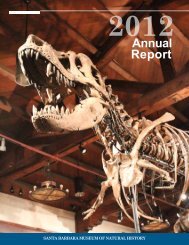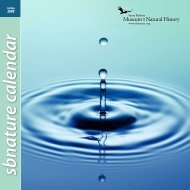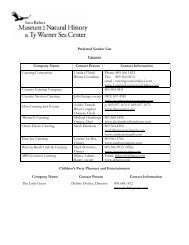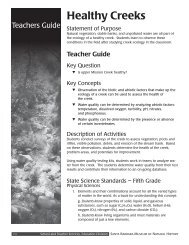Santa Barbara Museum of Natural History 2559 Puesta del ... - BioOne
Santa Barbara Museum of Natural History 2559 Puesta del ... - BioOne
Santa Barbara Museum of Natural History 2559 Puesta del ... - BioOne
Create successful ePaper yourself
Turn your PDF publications into a flip-book with our unique Google optimized e-Paper software.
The Coleopterists Bulletin, 58(4):603–609. 2004.DESCRIPTION OF THE FIRST OLD WORLD PEPLOGLYPTUS LECONTE(COLEOPTERA: HISTERIDAE: ONTHOPHILINAE)MICHAEL S. CATERINO<strong>Santa</strong> <strong>Barbara</strong> <strong>Museum</strong> <strong>of</strong> <strong>Natural</strong> <strong>History</strong><strong>2559</strong> <strong>Puesta</strong> <strong>del</strong> Sol Rd.<strong>Santa</strong> <strong>Barbara</strong>, CA 93105-2998, U.S.A.mcaterino@sbnature2.orgAbstractA new species <strong>of</strong> Peploglyptus LeConte (Peploglyptus mulu Caterino), previously known onlyfrom the Americas, is described from Malaysia. Like the New World species, P. mulu possessespronotal and prosternal trichomes, indicative <strong>of</strong> myrmecophilous associations.Peploglyptus LeConte is an enigmatic genus <strong>of</strong> onthophiline histerid beetles, until thisstudy known from only two New World species, P. belfragei LeConte and P. golbachiKanaar. The former is rare but apparently widespread in the southern United States,described from Texas (LeConte 1880), and reported also from Oklahoma, Arkansas, andKansas (Kovarik and Caterino 2000). Peploglyptus golbachi was described from Bolivia(Kanaar 1981), and is now also known from Paraguay (Mazur 1997). A few specimens <strong>of</strong>either this latter species or a very similar undescribed one are known from Panama, CostaRica, and Mexico (P. Kovarik, pers. comm.; A. Tishechkin, pers. comm.; Z. Falin, pers.comm.). The genus is known from a total <strong>of</strong> fewer than 20 specimens. Two specimens <strong>of</strong>an undescribed onthophiline were recently discovered in the <strong>Natural</strong> <strong>History</strong> <strong>Museum</strong>,London, from Gunung Mulu National Park in Sarawak, Malaysia (Fig. 1). Althoughsuperficially rather different from the described species <strong>of</strong> Peploglyptus, this speciesshares many unique features with them, and is unquestionably closely related. This newspecies extends the geographical and morphological range <strong>of</strong> the genus considerably.Although cited here in Onthophilinae, the affinities <strong>of</strong> Peploglyptus are rather unclear.Slipinski and Mazur (1999) found support for a monophyletic Onthophilinae, includingPeploglyptus, arising from within a paraphyletic Tribalinae, the two together sister toa lineage comprising Hetaeriinae, Chlamydopsinae, and Histerinae. Tribalinae andOnthophilinae were wi<strong>del</strong>y separated in the results <strong>of</strong> analyses by Caterino and Vogler(2002), with Tribalinae alone occupying a similar position, and Onthophilinae resolvingas basal to most or all other Histeridae. However, despite more comprehensive charactersampling (18S, adult, and larval data) in this latter study, taxonomic sampling wassparser, and the relationships <strong>of</strong> Peploglyptus were not specifically addressed. It isapparent that Peploglyptus shares many character states with the nominally tribalineStictostix (unpubl. data), and both genera could well be placed in either subfamily undertheir current vague definitions. Caterino and Vogler (2002) also suggested a possiblerelationship <strong>of</strong> either or both <strong>of</strong> these genera to Chlamydopsinae, which also remains tobe specifically examined. The description <strong>of</strong> this new species <strong>of</strong> Peploglyptus shouldfacilitate future examinations <strong>of</strong> these troublesome phylogenetic relationships.Peploglyptus mulu, new species(Figs. 2–12)Holotype female: [Malaysia]: ‘‘SARAWAK: 4th Division Gn. Mulu NP.’’/ ‘‘nr. Camp1 150-200 m.’’/ ‘‘ex. flood refuse’’/ ‘‘P.M.Hammond & J.E.Marshall, v–viii.1978, B.M.1978-49’’ [;38 509 N, 1148,09E]; deposited in BMNH.603
604 THE COLEOPTERISTS BULLETIN 58(4), 2004Fig. 1.Map <strong>of</strong> Borneo, showing type locality.Paratype: 1, same data as type; BMNH.Description. Body elongate oval (Figs. 2, 3), widest just behind humeral corners, darklyrufescent.Dimensions (<strong>of</strong> holotype, in mm). Total (pronotal-elytral) length: 2.03; maximum (elytral)width: 1.62; pronotal length: 0.65; maximum pronotal width: 1.25; elytral length: 1.34; lengths <strong>of</strong>prosternum, mesosternum, metasternum, first visible abdominal sternite: 0.65, 0.09, 0.50, 0.25;propygidial length: 0.22; pygidial length: 0.47; lengths <strong>of</strong> protibia, mesotibia, metatibia: 0.59,0.58, 0.67.Head. antennal insertions high on frons, set within shallow emargination <strong>of</strong> upper anteriormargin <strong>of</strong> eye (Fig. 10); frons longer than wide, broadly depressed between strongly protuberantantennal bases, with prominent oblique carinae extended from antennal bases anteromesally, endingfreely before reaching clypeolabral suture; epistoma strongly convex, elevated above labrum; vertexand frons with dense polygonal microsculpture, this less evident between antennal bases and alonganterior margin <strong>of</strong> epistoma; labrum about twice as wide as long, weakly convex, narrowingarcuately to anterior margin, which is truncate to very shallowly emarginate; labral disk finelypunctate, with a single elongate seta on either side nearer lateral margin than midline; left mandibleapically bidentate, overlapping the right mandible in repose, their outer surfaces with fine puncturesand more basally with increasingly evident reticulate microsculpture; ventral mouthparts not studiedin minute detail, but the following are visible: maxillae prominent ventrally (cardo and stipes visiblein lateral view); cardo glabrous, shining; stipes with two prominent setae parallel to anterolateralmargin and few scattered minute setae; basal two maxillary palpomeres short, subequal, bearinginconspicuous setae along apical margins, with apparently only single longer setae near outer apex<strong>of</strong> penultimate; terminal maxillary palopmere about 2.25 times as long as penultimate, tapered and
THE COLEOPTERISTS BULLETIN 58(4), 2004605Figs. 2–4.Dorsal, ventral, and lateral photographs <strong>of</strong> Peploglyptus mulu Caterino.flattened slightly to rounded apex, lacking conspicuous setae; submentum strongly deflexed,anteriorly with transverse row <strong>of</strong> about 3 elongate setae near anterior margin, disk with reticulatemicrosculpture (mentum, maxilla, and labium lacking conspicuous microsculpture); mentum flat,anterior margin weakly tridentate, with prominent median tooth, but with anterolateral corners onlyfaintly angulate; disk <strong>of</strong> mentum with about 3 elongate setae in irregular arrangement near middleand with much finer setae sparsely scattered throughout; basal labial palpomere very short,penultimate about 3 times as long, and expanded to apex, terminal labial palpomere about 1.25 timesas long as penultimate, slightly swollen basally, tapered to narrowly rounded apex, with few finesetae on outer surface. Antennal insertion immediately anterior to dorsal margin <strong>of</strong> eye, somewhathooded dorsally, open ventrally; scape (Fig. 9) as long as eye, ovoid in cross section, widest justbeyond middle, with an angulate emargination at posterior apex, a single elongate seta arising fromthe inner apex; scape in repose resting along anterior margin <strong>of</strong> eye, its inner surface arcuate andshallowly concave, its anterior surface with reticulate microsculpture and very fine setae; pedicel(Fig. 9) inserted in angulate posteroapical emargination <strong>of</strong> scape, abruptly curved and widened frombase, about one-fourth length <strong>of</strong> scape, with sparse setae subequal in length to its diameter;
606 THE COLEOPTERISTS BULLETIN 58(4), 2004Figs. 5–10. Peploglyptus mulu Caterino. 5) Posterior (outer) face <strong>of</strong> protibia; 6) anterior(outer) face <strong>of</strong> mesotibia; 7) anterior (outer) face <strong>of</strong> metatibia; 8) metatarsus; 9) lateral view <strong>of</strong> leftantenna; 10) lateral view <strong>of</strong> head (antenna not shown) and prothorax (pronotal and prosternaltrichomes stippled).antennomeres 3–8 short, cylindrical, approximate ratio <strong>of</strong> lengths 1.67:1:1:1:1:1.34; antennomeres3–7 with crown <strong>of</strong> short subapical setae; antennal club widest near base, somewhat acuminate,undivided with annuli inconspicuous, some setae in irregular transverse bands, setae moreirregularly scattered and elongate toward apex.Dorsum. Prothorax noticably narrower than elytra at base (with apex <strong>of</strong> pr<strong>of</strong>emur resting on base<strong>of</strong> elytra in repose), sides strongly sinuate, narrowed strongly anterad; anterior pronotal marginbroadly emarginate; deepest lateral emargination <strong>of</strong> pronotum approximately two-thirds from base,continuous with deep dorsolateral pit (trichome), these connected across dorsum by shallow,
THE COLEOPTERISTS BULLETIN 58(4), 2004607Figs. 11–12.gonostyle.Peploglyptus mulu Caterino. 11) Ovipositor; 12) detail <strong>of</strong> apex <strong>of</strong> coxite andposteriorly arcuate, transverse depression, these pits and connecting depression lined with clubbedsetae, strongly encrusted with adherent soil particles (likely to obscure trichome almost entirely;Figs. 2, 4); pronotal disk immediately in front <strong>of</strong> transverse depression with broad, slightly elevated,shallowly bifid tubercle, this bearing clustered clubbed setae at apices; pronotum otherwise withsmaller clubbed setae lining anterior and lateral margins, as well as sparsely scattered in front <strong>of</strong>transverse depression; basal one-third with only very minute setae, shining, with large, shallow,umbilicate punctures separated by slightly less than their widths basally, becoming sparser nearertransverse depression.Elytra broad, convex, sides rounded, strongly narrowed to apex; basal elytral margin finelycrenulate; scutellum visible, small, triangular; elytral dorsum with two prominent longitudinalcostae laterally (apparently corresponding to the inner subhumeral and stria 1), and two very weakcostae (putatively dorsal striae 3 and 5), their crests with short clubbed setae, intervals between
608 THE COLEOPTERISTS BULLETIN 58(4), 2004them shallowly depressed, with minute scale-like setae and large umbilicate punctures, botharranged in more or less distinct longitudinal series; sutural stria absent; epipleuron with additionalcostae, one (outer subhumeral?) arcuate from basal corner nearly to midpoint <strong>of</strong> inner subhumeral,which it joins, the other sinuately following ventral epipleural margin.Propygidium transverse about 33 as wide as long, nearly vertical, depressed along anteriormargin, but with apical margin elevated; pygidium about as long as wide, sides arcuate, more orless flat, weakly depressed in anterior corners; both propygidium and pygidium densely encrustedwith soil, surface texture obscured.Sterna. Prosternum (Fig. 3) about half as long as prothoracic width; prosternal keel broad,emarginate posteriorly, with oblique, wi<strong>del</strong>y separated longitudinal carinae in basal half, broadlydepressed between carinae (though faintly elevated along midline); prosternum transverselydepressed at middle, with deeply impressed trichomes on either side immediately adjacent to keel;setae <strong>of</strong> trichomes not evident, but likely visible in clean specimens, the transverse and lateraldepressions densely encrusted with fine soil particles in types; prosternal disk laterally with elevatedsinuate carina extending from inner corner <strong>of</strong> procoxa anterad along outer margin <strong>of</strong> trichome,thence laterad asymptotically to anterior prosternal margin; a short longitudinal carina extendedbetween lateral corner <strong>of</strong> procoxa and anterior prosternal margin, the prosternal disk between thesecarinae glabrous, with reticulate microsculpture and large dense umbilicate punctures; anteriorprosternal margin sinuate, with lobe bluntly produced beneath head. Mesosternum short, nearly 83as wide as long, anterior margin sinuate, weakly projecting at middle, disk finely punctate, with shortmarginal stria only in extreme lateral corners; mesometasternal suture arcuate, finely impressed;mesepimeron extending from mesocoxa nearly to humeral elytral corner (not meeting pronotum), itsanterior surface excavate for reception <strong>of</strong> procoxa, ventral surface with large, deep punctures;median metasternal suture finely impressed, obsolete only at posterior extreme; metasternal diskwith shallow umbilicate punctures separated by slightly more than their widths, with finer puncturesinterspersed; postmesocoxal stria extending from inner corner <strong>of</strong> coxa arcuately to inner edge <strong>of</strong>metepisternum; metepisternum exposed, narrowed by about one-third anterad, with single series <strong>of</strong>deep, closely set punctures; metepimeron triangular, with inner apex bluntly meeting metacoxa,coarsely punctate. First visible abdominal sternite short, broad, punctate as on metasternum, withpostmetacoxal stria extending from inner metacoxal corner sinuately to posterior margin <strong>of</strong> sternite;other abdominal sternites very short, largely concealed, with few coarse punctures and reticulatemicrosculpture at sides.Legs. Pr<strong>of</strong>emur tapered to apex, undersurface flat, longitudinally depressed along apical twothirds<strong>of</strong> posteroventral margin, shallowly punctate and with reticulate microsculpture; meso- andmetafemora slender, lower surfaces convex, depressed along posterior margins, with reticulatemicrosculpture and small punctures each bearing a minute scale-like seta (these faintly evident, andpossibly abraded, in pr<strong>of</strong>emoral punctures as well); protibia (Fig. 5) with inner margin weaklyarcuate, finely setose, outer margin more broadly arcuate, widest about two-thirds from base, withcontinuous series <strong>of</strong> small stout spines extending nearly to apex, the distal-most slightly set apartfrom, and markedly larger than, those preceding; apex <strong>of</strong> protibia without evident spurs, but withfew small apical spines; tarsal groove <strong>of</strong> upper surface poorly developed, evident only near apex,tarsi apparently not fully retractile; meso- and metatibiae (Figs. 6, 7) more slender, with spines <strong>of</strong>outer margins finer, little more than scale-like setae; meso- and metatarsi nonretractile; all tarsi (Fig.8) similar, 5-5-5, approximate ratio <strong>of</strong> tarsomere lengths 1.25:1:1:1:2.25, laterally compressed, withfine, sparse setae on upper surfaces, and (on tarsomeres 1–4) two longitudinal series <strong>of</strong> 2–3 spinesventrally; ultimate tarsomere expanded apically, rounded; pretarsal claws nearly straight, onlyslightly divergent, nearly as long as ultimate tarsomere.Ovipositor. Valvifer (Fig. 11) paddlelike, proximal expanded surface weakly sclerotized;coxite (Figs. 11, 12) 0.83 as long as valvifer, strongly sclerotized, bidentate, with elongate setae oninner surfaces (arrangement <strong>of</strong> setae shown in Fig. 11 is mirrored exactly on opposing coxite);gonostyle cylindrical, bearing 2 setiform, and 3–4 digitiform setae at apex; short digitiform setapresent in articulating membrane at base <strong>of</strong> gonostyle.Etymology. Mulu is the name <strong>of</strong> the highest peak in Gunung (Mt.) Mulu National Park.DiscussionThe placement <strong>of</strong> this new species in Peploglyptus is supported principally by theshared pronotal and prosternal trichomes. They are nearly identical in form and
THE COLEOPTERISTS BULLETIN 58(4), 2004609placement in all three species. While trichomes are found in scattered taxa throughoutthe Histeridae, the configuration seen in these is unique. Other likely synapomorphiesinclude the sinuate borders <strong>of</strong> the pronotum, the elevation <strong>of</strong> (putatively) elytral striae1, 3, 5 and the inner and outer subhumerals as costae (albeit weak ones in P. mulu), andfurther by the inner and outer subhumerals joining before the elytral midpoint. Thestraight, approximate tarsal claws <strong>of</strong> P. mulu are clearly apomorphic, and are reportedlyshared by P. golbachi (Tishechkin, pers. comm.), but these have not been adequatelydescribed in P. belfragei to determine if they are shared by all three. Synapomorphiesmight also be sought in the chaetotaxy <strong>of</strong> the ovipositor, although it remains to bedescribed in either <strong>of</strong> the New World species.The differences between P. mulu and the two New World Peploglyptus are alsonoteworthy. Most significantly, the rounded body form <strong>of</strong> the Malaysian speciescontrasts strongly with the quadrate New World species. The elevated bifid pronotaltubercle <strong>of</strong> P. mulu is also unique. On the pronotal disk <strong>of</strong> P. mulu there is no indication<strong>of</strong> the longitudinal costae leading to the lateral trichomes seen in the New Worldspecies, and the lateral sinuation <strong>of</strong> the pronotum is more strongly pronounced inP. mulu. As mentioned above, the dorsal elytral costae, especially those attributed hereto striae 3 and 5, are only weakly developed in P. mulu. It is perhaps significant to notethat the inner-most costa <strong>of</strong> P. belfragei has been described as ‘‘only visible as a veryfaint elevation in the basal 0.5’’ (Kanaar 1981). The basal marginal elytral costa seen inboth P. belfragei and P. golbachi is not at all indicated in P. mulu.The habits <strong>of</strong> all <strong>of</strong> the species <strong>of</strong> Peploglyptus remain open to conjecture. Collectiondata associated with the types <strong>of</strong> P. mulu (‘‘ex. flood refuse’’) strengthen a reportedassociation with flood debris (for P. belfragei; Kanaar 1981; Kovarik and Caterino2000), but contributes nothing to speculations <strong>of</strong> myrmecophily, suggested by thepresence <strong>of</strong> trichomes (and reported for a single collection <strong>of</strong> P. belfragei; Kovarik andCaterino 2000). Thus Peploglyptus remains a biological and phylogenetic enigma, andis now a biogeographic one as well.AcknowledgmentsI thank P. Hammond, M. Bren<strong>del</strong>l, and S. Hine for facilitating my histerid studies atthe <strong>Natural</strong> <strong>History</strong> <strong>Museum</strong> (carried out largely during a postdoctoral fellowshipsupported by a Leverhulme Trust grant to A. Vogler). I also thank Z. Falin, P. Kovarik,and A. Tishechkin for providing information on New World Peploglyptus, andA. Tishechkin and one anonymous reviewer for valuable comments on the manuscript.Literature CitedCaterino, M. S., and A. P. Vogler. 2002. The phylogeny <strong>of</strong> the Histeroidea (Staphyliniformia).Cladistics 18:394–415.Kanaar, P. 1981. Two new Neotropical Histeridae, with a redescription <strong>of</strong> Peploglyptus belfrageiLeConte. Acta Zoologica Lilloana 26:45–51.Kovarik, P. W., and M. S. Caterino. 2000. Histeridae [pp. 212–227]. In: American Beetles,Volume 1 (R. H. Arnett, Jr. and M. C. Thomas, editors). CRC Press, Boca Raton, Florida,443 pp.LeConte, J. L. 1880. Short studies <strong>of</strong> North American Coleoptera. Transactions <strong>of</strong> the AmericanEntomological Society 8:163–218.Mazur, S. 1997. A world catalogue <strong>of</strong> the Histeridae (Coleoptera: Histeroidea). Genus,International Journal <strong>of</strong> Invertebrate Taxonomy (Supplement): 1–373.Slipinski, S. A., and S. Mazur. 1999. Epuraeosoma, a new genus <strong>of</strong> Histerinae and phylogeny <strong>of</strong>the family Histeridae (Coleoptera: Histeroidea). Annales Zoologici 49:209–230.(Received 14 September 2003; accepted 16 February 2004. Publication date 24 January 2005.)


